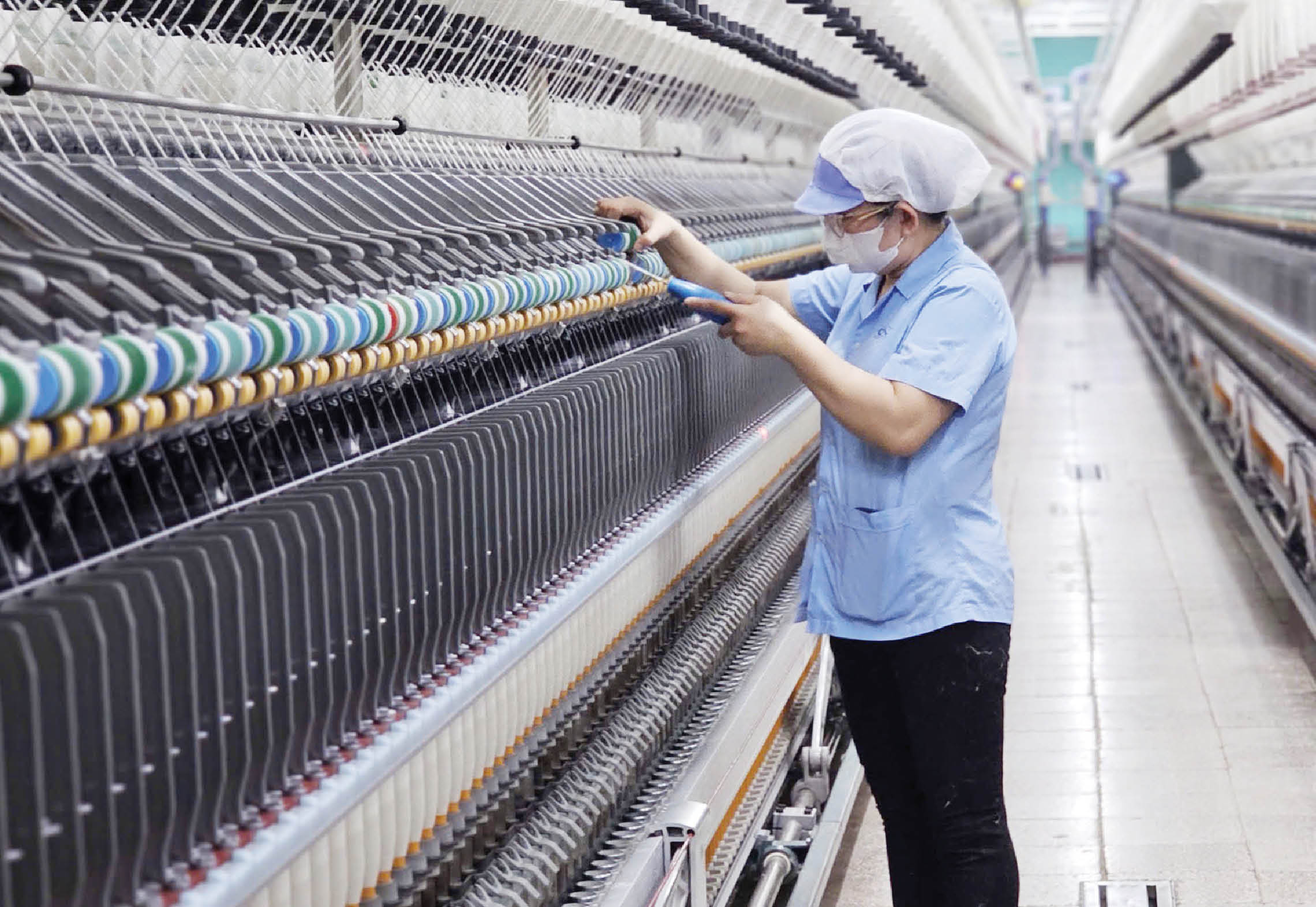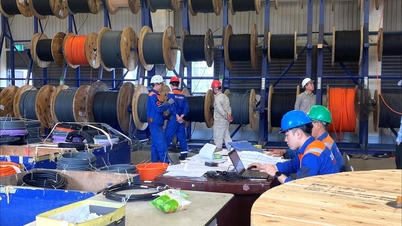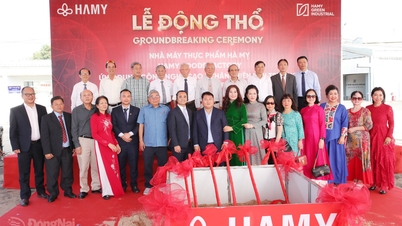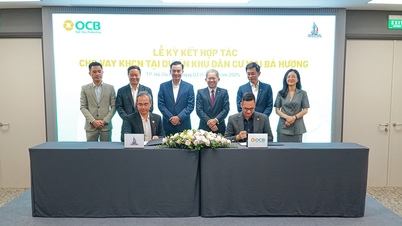 |
| Thanks to the application of technology, Hue Textile and Garment Joint Stock Company has optimized labor productivity. Photo: Hai Thuan |
Challenge
To successfully implement the two 100-year strategic goals, the Politburo has recently issued many important and strategic resolutions related to many areas of socio-economic life. The National Assembly and the Government have been urgently institutionalizing these resolutions to soon put them into practice in order to bring the country to rapid and sustainable development. The immediate goal is to achieve a GDP growth rate of over 8% this year, and from 2026 onwards, GDP growth will reach double digits.
While the total labor force of our country is growing slowly, in the period of 2021 - 2024 it only increased by an average of 0.96%/year, if we want to increase the scale, GDP growth rate and GDP per capita, there is no other way but to increase labor productivity. Therefore, labor productivity is the final decisive factor to successfully implement the growth targets set by our Party and State. Effectively exploiting the opportunities of the fourth industrial revolution, applying artificial intelligence (AI), implementing three strategic breakthroughs, breakthroughs in science and technology development, innovation and national digital transformation, selectively attracting FDI... are ultimately aimed at improving labor productivity. In turn, labor productivity will have an impact on increasing the scale of GDP; GDP/capita, state budget revenue and the country's potential. Without solving the problem of increasing labor productivity, all the set goals will be difficult to achieve.
In 2024, Vietnam's labor productivity at current prices will reach 221.9 million VND/worker, 1.3 times higher than in 2021. At comparable prices, labor productivity in 2024 will increase by 6.7 million VND compared to 2023. On average, in the 2011 - 2015 period, labor productivity will increase by 4.53%/year; in the 2016 - 2020 period, it will increase by 6.05% and in the 2021 - 2024 period, it will increase by 4.84%/year.
 |
| Applying modern technology in production contributes to improving labor productivity. Photo: L. Tho |
In the ASEAN region, Vietnam's labor productivity has been increasing steadily at a high rate, but the scale is still low compared to many countries in the region. In the period 2011 - 2023, Vietnam's labor productivity according to purchasing power parity in 2021 (PPP 2021) increased by an average of 5.2%/year, higher than the average growth rate of Malaysia (1.7%/year), Singapore (1.9%/year), Thailand (1.9%/year), Philippines (2.8%/year), Indonesia (2.9%/year). However, Vietnam's current labor productivity level is still very low compared to other countries in the region. According to PPP 2021, Vietnam's labor productivity in 2023 reached 24,519 USD, only equal to 11.4% of Singapore's; 15% of Brunei's; 35.5% of Malaysia's; 65.4% of Thailand's; 85.6% of Indonesia's. Notably, after 14 years, the gap in labor productivity between Vietnam and some more developed countries tends to increase, specifically: The gap in labor productivity (calculated according to PPP 2021) of Singapore from 168,260 USD in 2010 to 190,924 USD in 2023; similarly, Malaysia from 42,465 USD to 44,526 USD. On the contrary, the gap in labor productivity between Vietnam and some countries tends to decrease: Compared to Brunei, it decreased from 177,651 USD to 137,498 USD; Japan decreased from 70,996 USD to 60,810 USD; Thailand decreased from 16,504 USD to 12,957 USD; Indonesia decreased from 6,947 USD to 4,133 USD.
Thus, our country’s labor productivity has improved significantly and narrowed the gap with some ASEAN countries with higher levels of development, but is still low compared to some countries in the region. This shows that Vietnam’s economy will have to face great challenges to catch up with other countries in the coming time.
Salary increase must be accompanied by efforts to create wealth and material things.
There are many reasons why Vietnam's labor productivity is low and still far behind other countries in the ASEAN region, such as: The labor structure by industry is not reasonable, the proportion of labor in the agricultural sector where labor productivity is low is still high; the rate of informal labor is still high, most of them are simple labor, seasonal work, and unstable. In addition, economic growth mainly relies on expanding the scale of labor-intensive industries, low technology content and added value. The business sector has a large contribution to GDP growth, but most of them are domestic enterprises with micro and small scale, operating in fields with relatively low labor productivity, simple production mainly targeting the domestic market. Human resources have not met the requirements, the integration ability of Vietnamese workers is not high, skill level is still low; machinery, equipment and technology are outdated, slow to innovate...
According to statistics from the International Labor Organization, the statutory monthly minimum wage, calculated by purchasing power parity (PPP 2021), in Vietnam in 2022 will reach 543 USD, 4.2 times higher than in 2010. Although the growth rate of Vietnam's minimum wage is higher than other countries, the absolute number is lower than that of more developed countries. Vietnam's minimum wage in 2022 is higher than that of the Philippines (397 USD) and Laos (323 USD) but only 34% of that of Japan, 26% of that of South Korea, 54% of that of Malaysia and 72% of that of Thailand. Therefore, Vietnam needs to have a roadmap to increase the minimum wage in a direction that gradually approaches that of more developed countries in the region to ensure the lives of workers, create motivation to promote increased labor productivity, and shorten the gap with more developed countries.
Solving the problem of increasing labor productivity is always a matter of survival for every economy in general and our country in particular. To escape the middle-income trap, to stand shoulder to shoulder with the world powers and successfully implement the two strategic goals set for 2030 and 2045, there is no other way but to find every way to increase labor productivity. Each worker needs to strive to create more wealth and material for themselves and for the country.
Source: https://huengaynay.vn/kinh-te/cai-thien-nang-suat-lao-dong-158690.html


![[Photo] 60th Anniversary of the Founding of the Vietnam Association of Photographic Artists](/_next/image?url=https%3A%2F%2Fvphoto.vietnam.vn%2Fthumb%2F1200x675%2Fvietnam%2Fresource%2FIMAGE%2F2025%2F12%2F05%2F1764935864512_a1-bnd-0841-9740-jpg.webp&w=3840&q=75)


![[Photo] National Assembly Chairman Tran Thanh Man attends the VinFuture 2025 Award Ceremony](/_next/image?url=https%3A%2F%2Fvphoto.vietnam.vn%2Fthumb%2F1200x675%2Fvietnam%2Fresource%2FIMAGE%2F2025%2F12%2F05%2F1764951162416_2628509768338816493-6995-jpg.webp&w=3840&q=75)










































































































Comment (0)